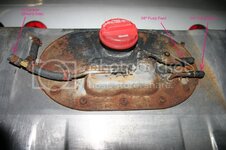ON the canister under the left fender, there is a engine manifold direct actuated vacuum actuated valve....as in why? who cares?? block it open and put it to the area above the throttle blades....it's under minor vacuum when engine running...and through the charcoal canister...
I followed the first part of your idea the first time. Just can't figure out why you think I need to change the way things are at the vacuum canister and engine when that part of the system is working just fine. I don't see a need to bubba things that work.

I just want a better built check valve.
DC
I have ONE functioning valve as of now, the other is outta the car and broken, when this one fails, I plan to drill a hole in the tank filler, which is high point center of the tank, mine being a '72, unsure if yours is a later shark....to that line is almost impossible to get gas into it, and so without any check valve can run to the canister up front....my comment about the canister is because I noted MINE had some failure, where the valve was stuck open....so I left the control line off, and let the ABOVE throttle blade vacuum source take whatever it wants outta the canister, seems to work fine, no smells in the garage...SO my only observation is it was much adoo over nothing, my tank runs under a slight/mild vacuum with engine running....you got NO idea the battle of the other way, sealed cap, and so with full tank building pressure here in HOT HUMID FLORIDA, and that check ball being held by expanding pressure, my house/garage door faces directly west...sunlight hit that car ass end and heat that tank a whole bunch...
gas smell, heat expansion, and so the float check valve was stuck closed with full tank....take the old UNvented cap off, and hear the fumes/gas escape upon release...WTF?? but only with full tank....
MY opinion from MY observations, it's a stupid design...sorry guys...just IS....
my concept of the high center on the filler neck just under the cap, to the opened up charcoal canister, open line to the lo vac air induction like mine happened to fail at....it's CASE CLOSED....
I didn't think this shit through.....I stumbled over it over some months....
:hissyfit::hissyfit::surrender:

